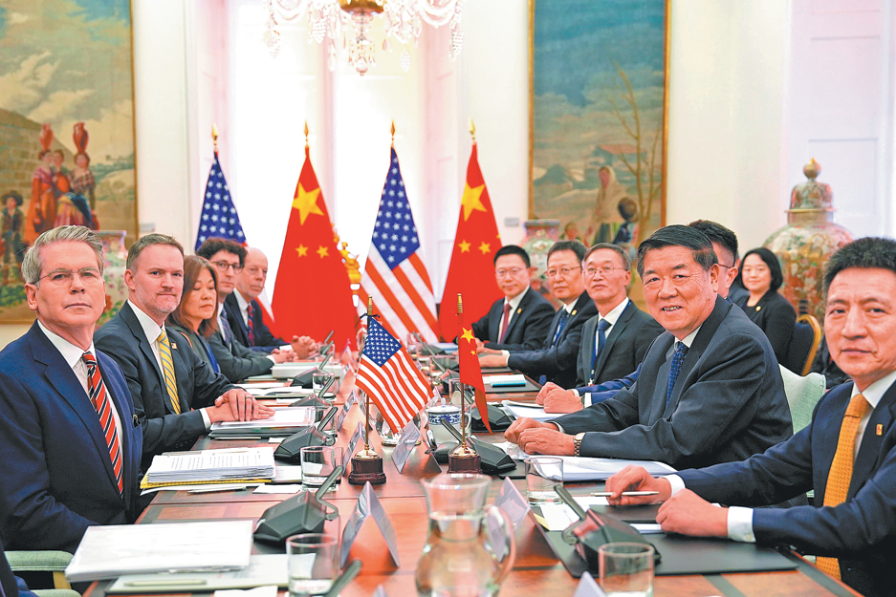Robust policies, reforms key to strong economy
By Guan Tao | China Daily | Updated: 2024-09-02 09:24

The expression "consolidating the foundation and boosting vitality" has been attracting market attention recently, after Chinese authorities said during a news conference that the country will stabilize economic growth in such a manner.
First-half data may provide deeper insight. First, the 5 percent economic growth was achieved during a period of transitioning between old and new growth drivers. Both Japan and the United States experienced economic and financial crises due to real estate market adjustments.
China, maintaining its strategic focus on high-quality development, has in recent years actively fostered new growth drivers through technological innovation, green development and digital transformation, striving to reduce reliance on real estate-driven growth.
Amid continued real estate market adjustments, private investment in the first half grew 0.1 percent year-on-year, while it grew by 6.6 percent excluding real estate investment. Investment in high-tech manufacturing and services nationwide also outpaced the overall fixed-asset investment growth rate by 6.2 and 7.8 percentage points, respectively.
Second, the resilience of the industry and supply chains underpins the recovery of external demand. The unexpected recovery in external demand was a significant highlight in the first half.
The decline of external demand for five consecutive months, which ended before the first quarter, positively contributed to the recovery, boosting economic growth by 0.7 percentage point in the first half. It significantly outpaced the year-on-year decline of 0.5 percentage point in real GDP growth.
The improvement in external demand benefited from the stabilization and recovery of the global economy and trade, and also reflects China's solid position in the global industrial and supply chains.
Amid rising global geopolitical tensions, China's market share in goods trade and two-way cross-border direct investment has generally increased since the COVID-19 pandemic began.
In fact, due to low yield rates, high costs and uncertain delivery times in overseas production, some manufacturers have returned to China, and some orders have started to flow back.
Third, increased infrastructure investment boosts domestic economic growth momentum. In the second quarter, the issuance of government bonds and local government bonds accelerated significantly, driving the implementation of government investment projects.
Infrastructure investment ended its three-month decline in June, with a year-on-year growth of 7.7 percent, up 1 percentage point from the previous month. Coupled with faster growth in manufacturing investment due to the recovery in external demand, capital formation contributed 1.88 percentage points to economic growth in the second quarter, a quarter-on-quarter increase of 1.25 percentage points, playing a crucial role in stabilizing growth.
Fourth, downward pressure on domestic prices has eased marginally. In the second quarter, the GDP deflator fell by 0.64 percent year-on-year, with the decline narrowing by 0.69 percentage point quarter-on-quarter, marking the smallest negative value since the second quarter of 2023.
Fifth, it was not uncommon globally for economies to experience a bumpy recovery path after the pandemic. This is mainly due to the significant impact of the pandemic on the production and consumption of various services.
After the pandemic came under control and as people-to-people exchanges gradually normalized, rapid recovery in the services sector led to a swift economic rebound. However, the momentum of the services sector recovery quickly weakened, dragging down overall economic recovery.
In July, China made it clear that the country would promote continuous economic recovery toward more balanced, inclusive and equitable development, relying on both robust policies and reform efforts.
Thus, several measures have been promoted or launched, including large-scale equipment upgrades and the replacement of old consumer goods with new ones, and 300 billion yuan ($42 billion) of ultra-long-term special bond funds are helping with the move.
Also, in July, the People's Bank of China — the country's central bank — unexpectedly announced a 10-basis-point cut to the seven-day reverse repo rate, and on the same day, lowered both the one-year and five-year loan prime rates, or LPR, by 10 basis points each. Later, it further reduced the one-year MLF, or medium-term lending facility, rate by 20 basis points. This signaled a stronger countercyclical adjustment and increased financial support for the real economy.
Consolidating the foundation and boosting vitality requires a combination of short-term and long-term measures, as well as a holistic approach to tackle both symptoms and root causes. Thus, reform is essential.
Accelerated efforts should be made to cultivate a complete domestic demand system, improve mechanisms for government investment effectively driving social investment, form a market-driven effective investment endogenous growth mechanism, enhance the long-term mechanism for expanding consumption, reduce restrictive measures and reasonably increase public consumption.
In addition, policies supporting services sector development should be improved, focusing on key links to promote high-quality development in productive services and establish mechanisms for accelerating diversified development in livelihoods.
A high-quality and sufficient employment promotion mechanism should be perfected, as well as mechanisms for determining wage levels, reasonable growth and payment guarantees. Income distribution and wealth accumulation should be regulated, and inclusive, basic and bottom-line social welfare construction should be strengthened to enhance household consumption capacity and appetites.
Amid rising challenges, China proposed substantial efforts during the third plenary session of the 20th Central Committee of the Communist Party of China in July.
For instance, the country proposed to improve the systems and mechanisms that promote high-quality economic development, refine the incentive and constraint mechanisms for driving high-quality development, and shape new growth drivers.
Also, efforts will be made to improve certain systems and mechanisms for integrated urban-rural development, and coordinate new industrialization, new urbanization and comprehensive rural vitalization.
In key areas such as real estate, local government debt, and small and medium-sized financial institutions, more measures will be taken to prevent and resolve risks. Safeguarding against systemic risks is a critical task at present, but the fundamental solution lies in building long-term mechanisms or developing new models, it was stated at the conference.
China's fundamental strength and economic resilience are solid. If all the reform tasks are successfully completed, a strong economy will lead to a strong currency. The strength of the renminbi over the medium to long term is assured, which is supported by robust economic fundamentals. As the economy returns to a reasonable range or the potential economic growth rate rises, yuan interest rates will naturally increase.
With better coordination of the capital market's investment and financing functions, domestic and international investors will ultimately share in the dividends of China's economic growth by holding renminbi-based financial assets over the long term.
The writer is global chief economist at BOC International.
The views don't necessarily reflect those of China Daily.
























